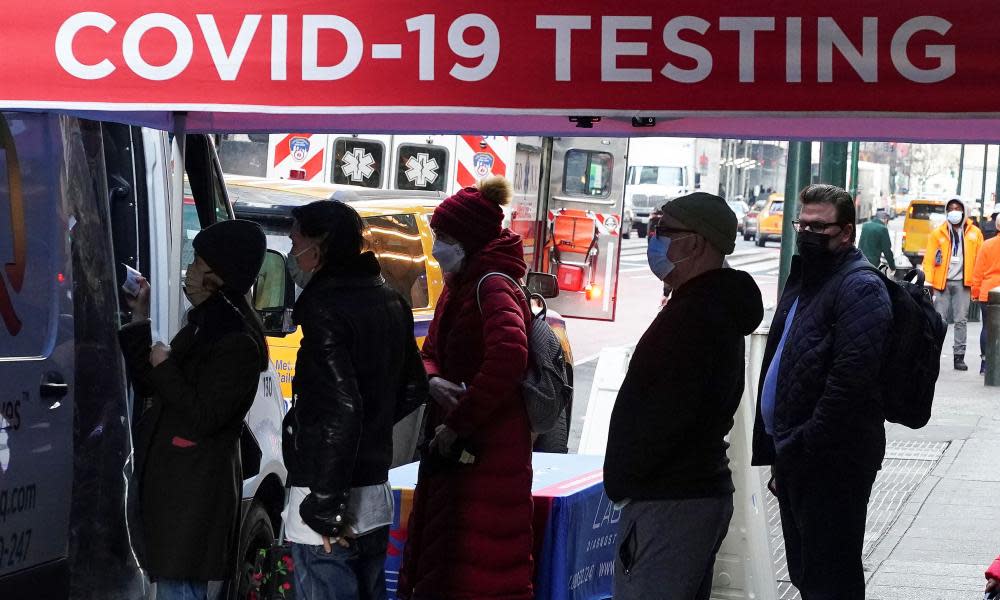New York and other north-eastern US states see a rapid fall in Covid cases

Despite decreasing positivity rates, hospitals continue to struggle amid a surging patient load and staff shortages
New York City and some north-eastern US states appear to be seeing rapid decreases in their numbers of Covid-19 cases in recent days, raising the possibility that the Omicron wave has now already peaked in some parts of America.
In New York City the rolling seven-day average of new cases was less than 28,000 a day on 16 January, down from an average of more than 40,000 on 9 January.
Similar patterns were being observed in the state as a whole and other nearby regions.
“The Covid forecast is improving … the Covid clouds are parting,” said Kathy Hochul, the New York governor, in a statement Sunday after releasing figures that showed positivity rates in the state are falling sharply. “Overall, the prognosis, the forecast, for Covid is much brighter than it had been before.”
Related: Is the US nearing its Covid peak? Experts warn against letting guard down
Some 400,000 tests were conducted in New York on Saturday, with a positivity rate of 12.9%. Just one week ago, on a similar number of tests, the positivity rate was almost 20%. The state reported 51,264 new cases on Saturday, down from the peak of more than 90,000 a week earlier, according to a New York Times database. The number of people hospitalized fell for a fourth straight day.
Several other north-east states – including New Jersey, Massachusetts, Connecticut and Rhode Island – may be heading in a similar, down-trending direction.
But in certain areas, including the Bronx in New York City, staff at hospital facilities have issued calls for help, saying they were struggling to treat a surging patient load.
“Patients are lying in the hallway on stretchers that are touching each other,” said Karen Lam, an emergency room nurse in the Bronx. President Joe Biden and Hochul said military medical and National Guard teams would be dispatched to help.
Over the weekend US surgeon general Vivek Murthy, warned that despite its rapid spread, Omicron had not yet peaked in the US as a whole. On a national level, the seven-day rolling average of new cases was still around 800,000 cases a day on 16 January, as it had been for the previous two days.
Murthy warned that infections are set to continue to increase in much of the country and the “next few weeks will be tough”. The rates of infection and levels of hospitalization are set to be much higher in unvaccinated populations.
“The challenge is that the entire country is not moving at the same pace,” Murthy said on CNN’s State of the Union. “The Omicron wave started later in other parts of the country. We shouldn’t expect a national peak in the coming days.”
The Biden administration has been battered by accusations that it failed to anticipate demand for testing after a national vaccine and re-vaccination or booster drive showed clear signs of faltering. The administration has also faced criticism that it failed to anticipate demand for therapeutic antiviral treatments.
The CDC, too, has faced criticism. With little available data on Omicron, the agency has attempted to move faster with recommendations, including by cutting the isolation periods and drop a negative test result as a requirement for leaving isolation.
But that was offset by employers requiring a negative test before infected Americans could return to work, creating pressure on testing capacity that authorities have struggled to meet.
CDC director Rochelle Walensky told the Wall Street Journal in an interview published Monday that she was committed to communicating CDC policy more clearly. “I think what I have not conveyed is the uncertainty in a lot of these situations,” Walensky said. “We felt the need to take action before we had Omicron-specific data,” she added.
In a statement last week, the White House said it would purchase $1bn tests to distribute free. A half-billion would be available for order on 19 January and mailed directly on request, with up to four free tests per residential address.
“This program will ensure that Americans have at-home, rapid COVID-19 tests available in the weeks and months ahead—in addition to the number of other ways they can get tested,” the White House said.

 Yahoo Movies
Yahoo Movies 
